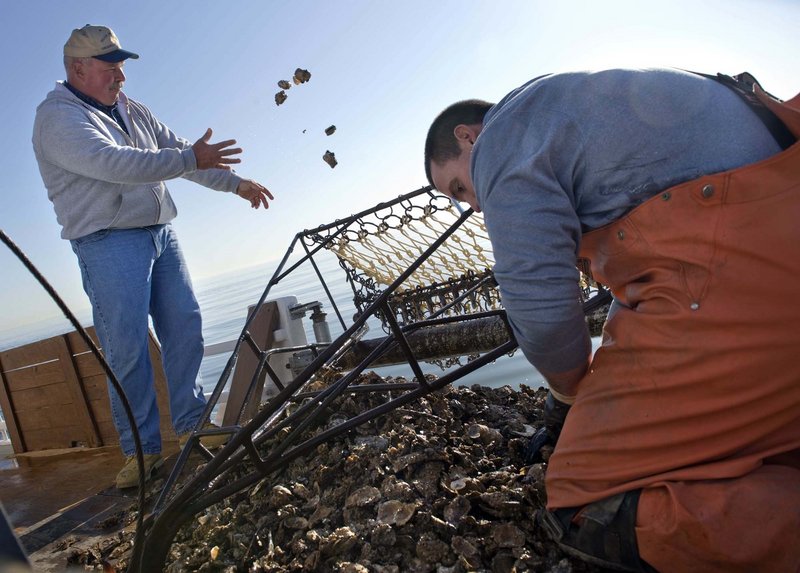Standing at the helm of his 106-year-old skipjack, Capt. Barry Sweitzer steered into the pre-dawn dark last week, eager to pull his first catch of the season from the northern Chesapeake Bay, the largest estuary in the United States. All summer, he’d been counting down the minutes until this day.
“I was ecstatic,” he said.
But as soon as the first batches of oysters were hauled onto the iconic oystering boat’s deck, Sweitzer knew his season was over. Of the 250 oysters caught in that initial “lick,” or pass over an oyster bed, 11 were alive.
“The oyster industry in the northern bay is gone,” he said.
Maryland’s Department of Natural Resources confirmed this week that at least 74 percent of the oysters north of the Chesapeake Bay Bridge died in the spring from record-high freshwater flows into the bay from the Susquehanna River, the East Coast’s longest river. The bay, bordered by Maryland and Virginia, is the largest estuary in the United States, with numerous rivers and streams emptying into it.
More recent flooding from tropical storms Irene and Lee also might have killed some oysters, which rely on salty waters to survive, said Mike Naylor, the department’s shellfish program director.
Only 2 percent of the bay’s oyster harvest comes from the upper bay, where about 30 watermen dredge for oysters between the Magothy and Patapsco rivers. So the effect of the die-off will be minimal to the overall industry, Naylor said.
But as the only skipjack captain who works in the hard-hit area, Sweitzer says the loss means that his oystering career has ended. And so has a family legacy. After catching barely two dozen live oysters Nov. 2 – compared with more than 100 bushels on the first day of last year’s season – he laid off his crew and put the Hilda M. Willing up for sale.
Poor water quality, over-harvesting and diseases have been killing off oysters in the bay for decades, bringing the population to less than 5 percent of its level in the 1800s, said Mark Bryer, director of the Nature Conservancy’s Chesapeake Bay Program.
It will take years of restoration efforts to repopulate the area with oysters, Naylor said. Until then, some species that depend on the oyster reefs as feeding grounds will be affected, including rockfish and blue crabs.
But the monetary loss isn’t even the most heartbreaking aspect of the die-off, said Sweitzer, who is 50. The worst part, he said, is “It’s a way of life that’s disappearing.”
Sweitzer’s father, Robert F. Sweitzer, bought the skipjack in 1947 and worked as its captain for 53 years to support his wife and five children.
The Willing, named in memory of the builder’s deceased daughter, was constructed in 1905, about 10 years after oyster-dredging boats began to dot the bay. Their high-water mark lasted about 20 years. In all, it’s believed that about 2,000 skipjacks were made.
When Robert Sweitzer wasn’t out on the water, he was repairing the boat, said his son, who remembers watching his father strip the bark off an eastern pine tree in the family’s yard on Tilghman Island to fashion the boat’s 40-foot boom, which supports the mainsail.
In 2000, Sweitzer took out a loan and bought the boat from his father for $30,000. Since then, he has captained the ship two days a week, weather permitting, during the November-through-March oyster season, supplying Deep Creek Restaurant and Marina near Annapolis and Virginia wholesalers with fresh catches. He also works as a marine officer with the Baltimore County police.
In 2000, skipjacks were named Maryland’s official state boat. The Willing, stout and sturdy and in better shape than most of its aging counterparts, did its colleagues one better, earning designation as a National Historic Landmark. It even has its own entry in Wikipedia. But most of the surviving wooden boats have deteriorated over the decades, leaving only six commercial oyster-dredging skipjacks on the bay.
On Tuesday, Sweitzer and crew member Kelly Sullivan took a final voyage to the upper bay oyster beds to show a reporter what they had found the previous week.
Sullivan, 24, lowered one of the boat’s two 4-foot-long, iron-toothed rakes into the bay. The dredges drag along the bottom of the bay, scooping oysters. Armed with gloves and kneepads, Sullivan hauled up the dredge after a few minutes and, on his hands and knees, sifted through the pile of broken, semi-attached and empty shells, pushing the dead ones back into the bay and setting aside a few he thought might be alive.
But as he tapped each “questionable” oyster with a cull hammer, most cracked open to reveal hollow interiors. He tasted a rare live one and cast the shell into the bay with disgust.
After Sweitzer docked his boat for the last time at the Deep Creek restaurant, Rene Hundemann, a co-owner, was there to greet him.
“We’re going to miss you,” she said.
Copy the Story Link
Send questions/comments to the editors.



Success. Please wait for the page to reload. If the page does not reload within 5 seconds, please refresh the page.
Enter your email and password to access comments.
Hi, to comment on stories you must . This profile is in addition to your subscription and website login.
Already have a commenting profile? .
Invalid username/password.
Please check your email to confirm and complete your registration.
Only subscribers are eligible to post comments. Please subscribe or login first for digital access. Here’s why.
Use the form below to reset your password. When you've submitted your account email, we will send an email with a reset code.